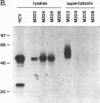Abstract
To investigate whether live attenuated pseudorabies virus (PRV) can be used as a vaccine vector, PRV recombinants that expressed envelope glycoprotein E1 of hog cholera virus (HCV) were generated. Pigs inoculated with these recombinants developed high levels of neutralizing antibodies against PRV and HCV and were protected against both pseudorabies and hog cholera (classical swine fever).
Full text
PDF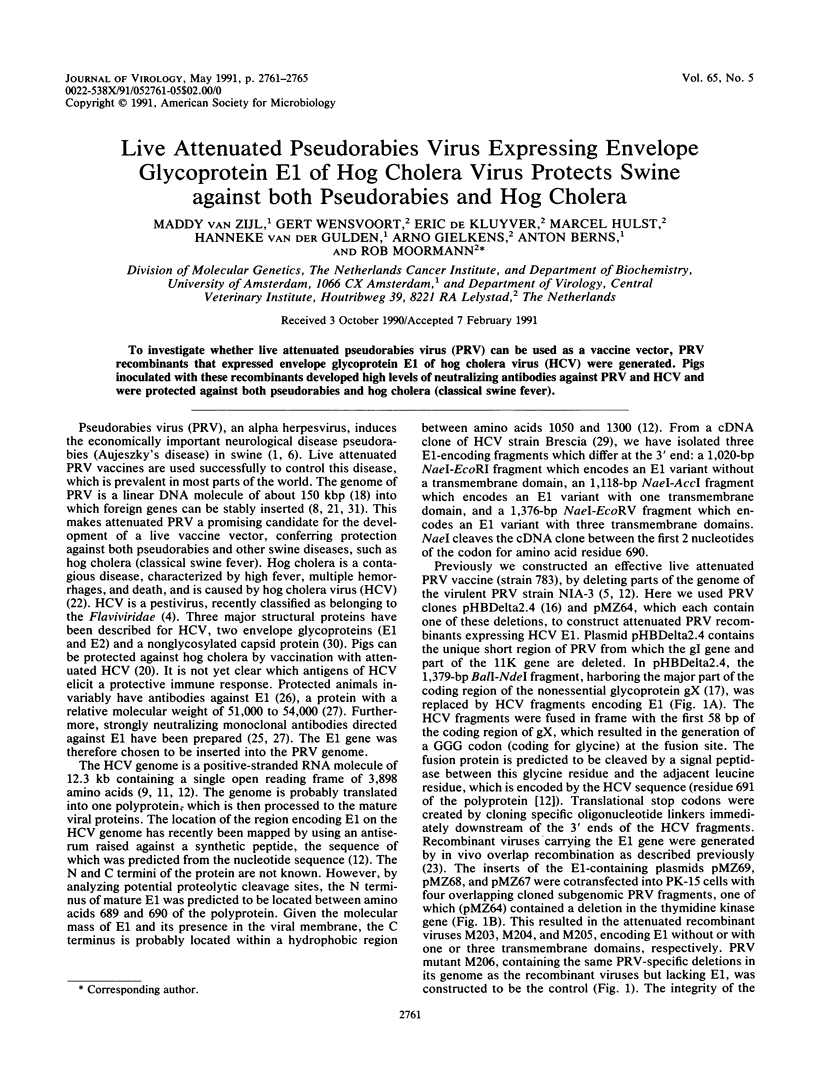
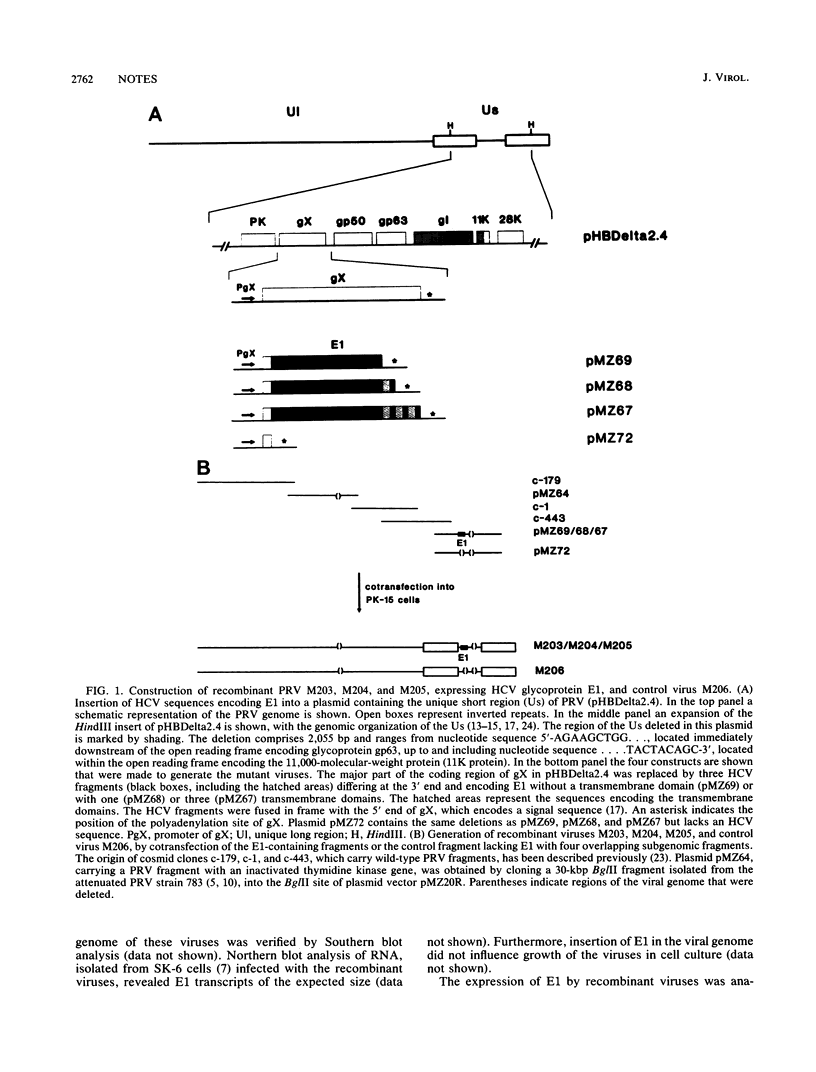
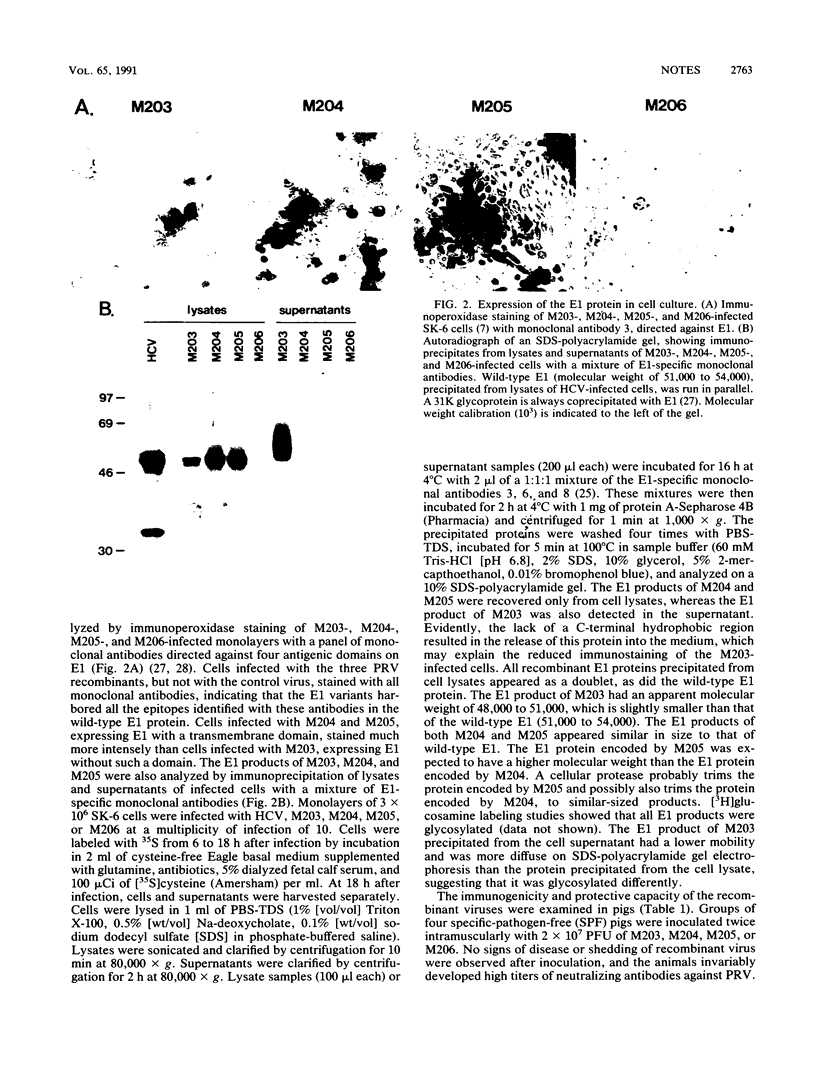
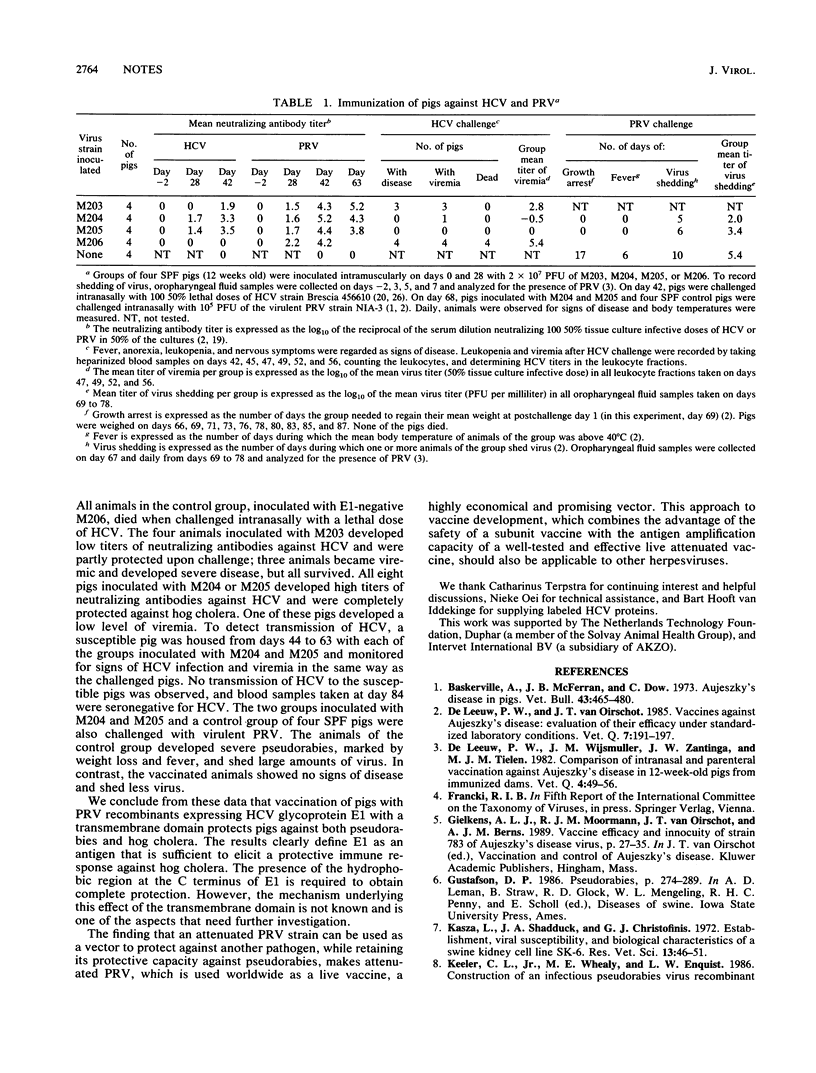
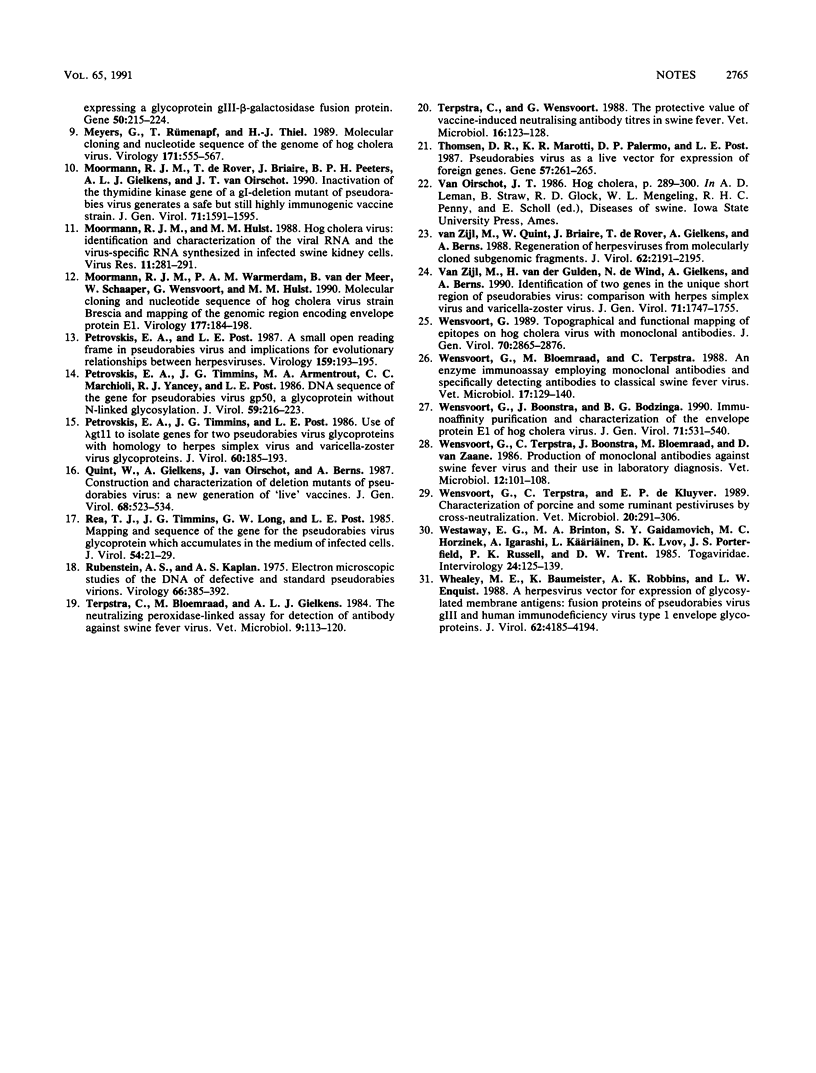
Images in this article
Selected References
These references are in PubMed. This may not be the complete list of references from this article.
- Kasza L., Shadduck J. A., Christofinis G. J. Establishment, viral susceptibility and biological characteristics of a swine kidney cell line SK-6. Res Vet Sci. 1972 Jan;13(1):46–51. [PubMed] [Google Scholar]
- Keeler C. L., Jr, Whealy M. E., Enquist L. W. Construction of an infectious pseudorabies virus recombinant expressing a glycoprotein gIII-beta-galactosidase fusion protein. Gene. 1986;50(1-3):215–224. doi: 10.1016/0378-1119(86)90326-4. [DOI] [PubMed] [Google Scholar]
- Meyers G., Rümenapf T., Thiel H. J. Molecular cloning and nucleotide sequence of the genome of hog cholera virus. Virology. 1989 Aug;171(2):555–567. doi: 10.1016/0042-6822(89)90625-9. [DOI] [PubMed] [Google Scholar]
- Moormann R. J., Hulst M. M. Hog cholera virus: identification and characterization of the viral RNA and the virus-specific RNA synthesized in infected swine kidney cells. Virus Res. 1988 Nov;11(4):281–291. doi: 10.1016/0168-1702(88)90002-0. [DOI] [PubMed] [Google Scholar]
- Moormann R. J., Warmerdam P. A., van der Meer B., Schaaper W. M., Wensvoort G., Hulst M. M. Molecular cloning and nucleotide sequence of hog cholera virus strain Brescia and mapping of the genomic region encoding envelope protein E1. Virology. 1990 Jul;177(1):184–198. doi: 10.1016/0042-6822(90)90472-4. [DOI] [PubMed] [Google Scholar]
- Moormann R. J., de Rover T., Briaire J., Peeters B. P., Gielkens A. L., van Oirschot J. T. Inactivation of the thymidine kinase gene of a gI deletion mutant of pseudorabies virus generates a safe but still highly immunogenic vaccine strain. J Gen Virol. 1990 Jul;71(Pt 7):1591–1595. doi: 10.1099/0022-1317-71-7-1591. [DOI] [PubMed] [Google Scholar]
- Petrovskis E. A., Post L. E. A small open reading frame in pseudorabies virus and implications for evolutionary relationships between herpesviruses. Virology. 1987 Jul;159(1):193–195. doi: 10.1016/0042-6822(87)90368-0. [DOI] [PubMed] [Google Scholar]
- Petrovskis E. A., Timmins J. G., Armentrout M. A., Marchioli C. C., Yancey R. J., Jr, Post L. E. DNA sequence of the gene for pseudorabies virus gp50, a glycoprotein without N-linked glycosylation. J Virol. 1986 Aug;59(2):216–223. doi: 10.1128/jvi.59.2.216-223.1986. [DOI] [PMC free article] [PubMed] [Google Scholar]
- Petrovskis E. A., Timmins J. G., Post L. E. Use of lambda gt11 to isolate genes for two pseudorabies virus glycoproteins with homology to herpes simplex virus and varicella-zoster virus glycoproteins. J Virol. 1986 Oct;60(1):185–193. doi: 10.1128/jvi.60.1.185-193.1986. [DOI] [PMC free article] [PubMed] [Google Scholar]
- Quint W., Gielkens A., Van Oirschot J., Berns A., Cuypers H. T. Construction and characterization of deletion mutants of pseudorabies virus: a new generation of 'live' vaccines. J Gen Virol. 1987 Feb;68(Pt 2):523–534. doi: 10.1099/0022-1317-68-2-523. [DOI] [PubMed] [Google Scholar]
- Rea T. J., Timmins J. G., Long G. W., Post L. E. Mapping and sequence of the gene for the pseudorabies virus glycoprotein which accumulates in the medium of infected cells. J Virol. 1985 Apr;54(1):21–29. doi: 10.1128/jvi.54.1.21-29.1985. [DOI] [PMC free article] [PubMed] [Google Scholar]
- Rubenstein A. S., Kaplan A. S. Electron microscopic studies of the DNA of defective and standard pseudorabies virions. Virology. 1975 Aug;66(2):385–392. doi: 10.1016/0042-6822(75)90211-1. [DOI] [PubMed] [Google Scholar]
- Terpstra C., Bloemraad M., Gielkens A. L. The neutralizing peroxidase-linked assay for detection of antibody against swine fever virus. Vet Microbiol. 1984 Apr;9(2):113–120. doi: 10.1016/0378-1135(84)90026-9. [DOI] [PubMed] [Google Scholar]
- Terpstra C., Wensvoort G. The protective value of vaccine-induced neutralising antibody titres in swine fever. Vet Microbiol. 1988 Feb;16(2):123–128. doi: 10.1016/0378-1135(88)90036-3. [DOI] [PubMed] [Google Scholar]
- Thomsen D. R., Marotti K. R., Palermo D. P., Post L. E. Pseudorabies virus as a live virus vector for expression of foreign genes. Gene. 1987;57(2-3):261–265. doi: 10.1016/0378-1119(87)90130-2. [DOI] [PubMed] [Google Scholar]
- Wensvoort G., Bloemraad M., Terpstra C. An enzyme immunoassay employing monoclonal antibodies and detecting specifically antibodies to classical swine fever virus. Vet Microbiol. 1988 Jun;17(2):129–140. doi: 10.1016/0378-1135(88)90004-1. [DOI] [PubMed] [Google Scholar]
- Wensvoort G., Boonstra J., Bodzinga B. G. Immunoaffinity purification and characterization of the envelope protein E1 of hog cholera virus. J Gen Virol. 1990 Mar;71(Pt 3):531–540. doi: 10.1099/0022-1317-71-3-531. [DOI] [PubMed] [Google Scholar]
- Wensvoort G., Terpstra C., Boonstra J., Bloemraad M., Van Zaane D. Production of monoclonal antibodies against swine fever virus and their use in laboratory diagnosis. Vet Microbiol. 1986 Jul;12(2):101–108. doi: 10.1016/0378-1135(86)90072-6. [DOI] [PubMed] [Google Scholar]
- Wensvoort G., Terpstra C., de Kluyver E. P. Characterization of porcine and some ruminant pestiviruses by cross-neutralization. Vet Microbiol. 1989 Aug;20(4):291–306. doi: 10.1016/0378-1135(89)90054-0. [DOI] [PubMed] [Google Scholar]
- Wensvoort G. Topographical and functional mapping of epitopes on hog cholera virus with monoclonal antibodies. J Gen Virol. 1989 Nov;70(Pt 11):2865–2876. doi: 10.1099/0022-1317-70-11-2865. [DOI] [PubMed] [Google Scholar]
- Westaway E. G., Brinton M. A., Gaidamovich SYa, Horzinek M. C., Igarashi A., Käriäinen L., Lvov D. K., Porterfield J. S., Russell P. K., Trent D. W. Togaviridae. Intervirology. 1985;24(3):125–139. doi: 10.1159/000149632. [DOI] [PubMed] [Google Scholar]
- Whealy M. E., Baumeister K., Robbins A. K., Enquist L. W. A herpesvirus vector for expression of glycosylated membrane antigens: fusion proteins of pseudorabies virus gIII and human immunodeficiency virus type 1 envelope glycoproteins. J Virol. 1988 Nov;62(11):4185–4194. doi: 10.1128/jvi.62.11.4185-4194.1988. [DOI] [PMC free article] [PubMed] [Google Scholar]
- de Leeuw P. W., Wijsmuller J. M., Zantinga J. W., Tielen M. J. Intranasal vaccination of pigs against Aujeszky's disease. 1. Comparison of intranasal and parenteral vaccination with an attenuated vaccine in 12-week-old pigs from immunized dams. Vet Q. 1982 Apr;4(2):49–56. doi: 10.1080/01652176.1982.9693839. [DOI] [PubMed] [Google Scholar]
- de Leeuw P. W., van Oirschot J. T. Vaccines against Aujeszky's disease: evaluation of their efficacy under standardized laboratory conditions. Vet Q. 1985 Jul;7(3):191–197. doi: 10.1080/01652176.1985.9693982. [DOI] [PubMed] [Google Scholar]
- van Zijl M., Quint W., Briaire J., de Rover T., Gielkens A., Berns A. Regeneration of herpesviruses from molecularly cloned subgenomic fragments. J Virol. 1988 Jun;62(6):2191–2195. doi: 10.1128/jvi.62.6.2191-2195.1988. [DOI] [PMC free article] [PubMed] [Google Scholar]
- van Zijl M., van der Gulden H., de Wind N., Gielkens A., Berns A. Identification of two genes in the unique short region of pseudorabies virus; comparison with herpes simplex virus and varicella-zoster virus. J Gen Virol. 1990 Aug;71(Pt 8):1747–1755. doi: 10.1099/0022-1317-71-8-1747. [DOI] [PubMed] [Google Scholar]




